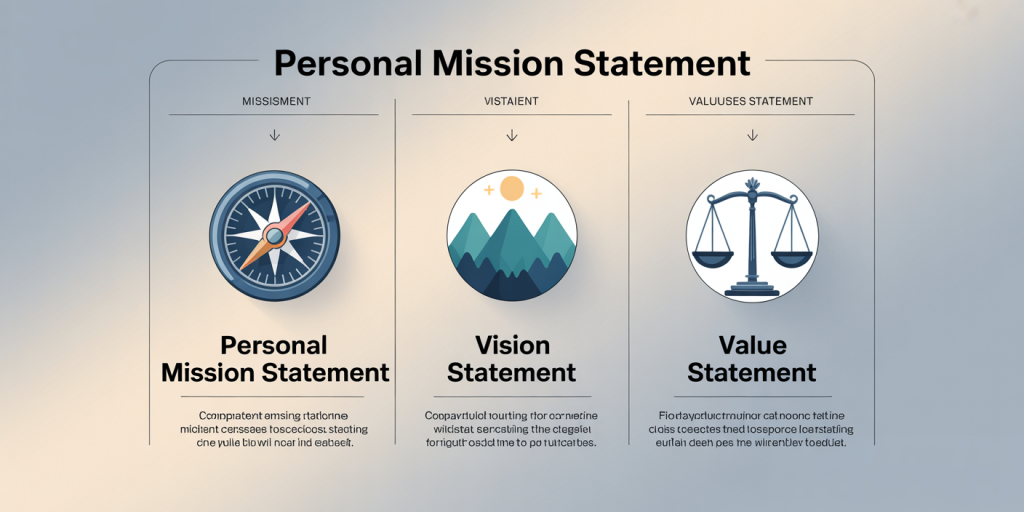Why You Should Create a “Personal Mission Statement” and How to Start
In today’s fast-paced world filled with constant distractions and shifting priorities, living with clarity and purpose has become more important than ever. A personal mission statement offers a guiding light amid complexity, helping individuals focus on what truly matters and consistently make decisions aligned with their core values. This tool, often used by successful leaders and entrepreneurs, not only enhances personal growth but also improves mental well-being and productivity.
Crafting a personal mission statement goes beyond writing a few inspiring sentences. It requires deep self-reflection, an understanding of your values, and a clear vision of the impact you want to have on your life and others around you. This article explores why creating a personal mission statement is essential and provides practical steps to help you start crafting your own, empowering you to live with intention and confidence.

A person thoughtfully writing their personal mission statement in a calm, inspiring environment surrounded by symbols of values like honesty, creativity, and community service.
Anúncios

A comparative infographic table visually differentiating Personal Mission Statement, Vision Statement, and Value Statement with clear headings, concise definitions, and symbolic imagery for each category.
Anúncios
Understanding the Importance of a Personal Mission Statement
A personal mission statement is a concise declaration of your purpose in life—your core values, goals, and the overarching guide for your behaviors and decisions. Unlike a professional mission statement, which focuses on career objectives, a personal mission statement encompasses all dimensions of your life, including relationships, health, personal growth, and community involvement.
Research suggests that people who articulate clear personal goals and values experience higher levels of motivation and well-being. According to a 2019 study by the University of Scranton, individuals who write down their goals are 42% more likely to achieve them. A personal mission statement functions as a cornerstone for these goals, ensuring they align with your true sense of self.
Take Oprah Winfrey, for example, whose personal mission has been to “be a teacher and a deeply compassionate humanitarian.” This guiding principle has propelled her career choices, philanthropic efforts, and leadership style, ultimately creating immense impact and personal satisfaction. Her mission statement not only aligns with her professional ventures but also her commitment to empowering others, serving as a north star in every endeavor.
The Psychological and Practical Benefits of Having a Mission Statement
Beyond providing clarity, a personal mission statement can significantly influence psychological and emotional well-being. Psychologists emphasize that a clear sense of purpose correlates with increased happiness and resilience. A 2020 study published in the Journal of Health Psychology found that individuals with a well-defined sense of purpose had a 15% lower risk of mortality and better mental health outcomes.

A conceptual illustration showing the psychological and practical benefits of a personal mission statement: increased motivation, clarity, resilience, and productivity represented with icons like a brain, heart, checklist, and upward graph.
Practically, a personal mission statement streamlines decision-making processes. When faced with difficult choices, you can ask yourself whether an option aligns with your mission, reducing stress and fostering confidence. For example, if your mission includes promoting family well-being, turning down a promotion that requires excessive travel may be easier to justify.
Moreover, it can enhance productivity. According to psychologist Teresa Amabile’s research on motivation, intrinsic motivation—driven by personal values and passions—leads to sustained engagement and higher performance. Your mission statement channels intrinsic motivation by anchoring daily actions to larger life goals, preventing drift and procrastination.
How to Start Creating Your Personal Mission Statement
Beginning your personal mission statement involves introspection and structured reflection. Start by asking yourself fundamental questions: What values are non-negotiable in my life? What kind of person do I want to be remembered as? What are my greatest strengths and passions? How do I want to contribute to those around me?
Writing down your answers helps in identifying recurring themes and core beliefs. For example, if honesty, creativity, and community service repeatedly appear, these elements become building blocks for your mission.
Next, consider writing a rough draft using the format: “To ____, in order to ____,” or “My mission is to ____ so that ____.” This helps maintain clarity and focus. For instance: “My mission is to empower others through creativity and honesty so that we build stronger, more compassionate communities.”
Seek feedback from trusted friends or mentors who know you well. They can offer insights on whether your statement authentically reflects your consciousness and potential. Be prepared to revise your statement repeatedly; it is a living document that evolves as you grow.
Comparative Table: Personal Mission Statement vs. Vision Statement vs. Value Statement
| Aspect | Personal Mission Statement | Vision Statement | Value Statement |
|---|---|---|---|
| Purpose | Defines your purpose and guides your day-to-day actions | Describes your long-term aspirations and dreams | Outlines your core principles and ethical standards |
| Time Frame | Present and ongoing | Future-oriented | Timeless, foundational |
| Focus | How and why you live your life | What you ultimately want to achieve | What you believe in and stand for |
| Use | Personal decision-making and behavior guidance | Inspiration and motivation for growth | Moral compass in choices and interactions |
| Example | “To inspire creativity and integrity in my community” | “To be recognized as a visionary leader in education” | “We value honesty, respect, and compassion” |
This table helps clarify distinctions, ensuring your personal mission statement remains practical and actionable rather than aspirational or abstract.
Real-Life Examples and Practical Applications
Many high-achieving individuals and organizations use mission statements for alignment and focus. Consider Jeff Bezos, whose Amazon mission is “to be Earth’s most customer-centric company.” While this is corporate, Bezos’ personal philosophy reportedly emphasizes long-term thinking and innovation, serving as a mission underpinning his actions and decisions.
On a smaller scale, imagine a teacher who develops a personal mission statement: “To empower each student’s potential through patience and creativity, fostering lifelong learning.” This mission informs their teaching style, professional development, and interactions with students and parents. It helps them remain motivated and connected to their purpose amid challenges.
Think about Sarah, a mid-level manager who felt overwhelmed by daily pressures and lacked clarity about her career path. After writing her personal mission statement—“To lead with empathy and integrity, helping teams grow and succeed”—she found it easier to prioritize tasks, advocate for workplace improvements, and mentor others. Her stress levels decreased, and job satisfaction improved, illustrating practical benefits of this exercise.
Key Steps and Tips to Perfect Your Personal Mission Statement
1. Dedicate Time for Self-Reflection: Allocate uninterrupted time, ideally in a relaxed setting, to explore your thoughts and values. Journaling over several days can reveal deep insights.
2. Identify Core Values: Create a prioritized list of values by examining what consistently drives your behavior and decisions.
3. Define Your Purpose: Articulate what motivates you intrinsically—what impact you wish to have on yourself and others.
4. Write and Refine: Draft your statement using simple but powerful language. Keep it concise—one to three sentences is ideal.
5. Align Goals With Your Mission: Use the mission statement to set SMART (Specific, Measurable, Achievable, Relevant, Time-bound) goals that reflect your purpose.
6. Review Regularly: Your mission may evolve as your life changes. Revisit and revise it periodically to ensure ongoing relevance.
7. Visualize and Affirm: Display your mission statement prominently or incorporate it into daily affirmations to reinforce focus.
How a Personal Mission Statement Supports Long-Term Success
Having a personal mission statement is linked to sustained success and meaningful achievements across life domains. A 2018 Harvard Business Review article noted that individuals who clearly articulate personal missions tend to experience higher career satisfaction and maintain better work-life balance. This occurs because their decisions consistently align with their priorities, reducing internal conflicts.
Furthermore, mission-driven individuals are more adaptable in times of change. For example, during the COVID-19 pandemic, many people reassessed their goals and values due to shifting circumstances. Those with personal mission statements adapted their strategies while staying true to core purposes, enabling resilience and innovation.
Psychologist Viktor Frankl asserted that a deep sense of purpose is essential for human survival and happiness, especially under adversity. Your personal mission statement becomes a psychological anchor, providing meaning and reducing anxiety during uncertain times.
Future Perspectives: Personal Mission Statements in the Evolving World
As global challenges become more complex—ranging from technological disruption to social inequality—the importance of individual purpose will only grow. Personal mission statements will help people navigate shifting landscapes with resilience and intentionality.
Technological advancements such as artificial intelligence and remote working environments require agility and self-direction. A clear personal mission can guide individuals through transitions, helping prioritize authentic goals over transient trends. Organizations increasingly recognize the value of mission-driven employees for fostering innovation and commitment, raising the relevance of personal mission statements in recruitment and professional development.
Moreover, the rise of holistic well-being movements highlights the need to integrate physical, emotional, social, and spiritual dimensions of health. Personal mission statements can serve as frameworks for balanced living, encouraging people to align all aspects of their lives toward fulfillment and contribution.
In the future, digital tools and platforms may facilitate mission statement creation and reinforcement through personalized coaching, visualization, and progress tracking. These innovations will deepen the connection between personal purpose and action, making mission statements not just inspirational words but actionable roadmaps.
In summary, creating a personal mission statement is a transformative process that empowers you to live with clarity, purpose, and motivation. Whether you seek greater fulfillment, productivity, or resilience, a well-crafted mission acts as a compass guiding your daily decisions and long-term goals. By dedicating time to reflect, define, write, and refine your mission, you invest in lifelong personal growth and success in an increasingly complex world. The journey begins with a single step—why not start yours today?
